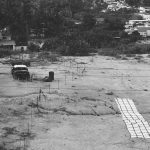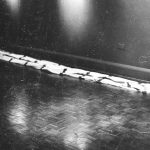Since the late 1960s, Eugenio Espinoza has perpetually challenged, explored and embraced art historical conventions in his prodigious output of installations, photography, paintings, drawings and sculptures. His practice evidences a profound and rigorous conceptual exploration of modernist traditions (Minimalism, Arte Povera, Geometric Abstraction) and an equally persistent and powerful conceptual and physical reworking of his own oeuvre.
Espinoza is best known for his monochromatic, minimalistic and nonfigurative manipulations of grid forms. Producing works as a reaction to the dominant tendencies of geometric abstraction and Kinetic art in Venezuela.
His series of Impenetrables are considered Espinoza’s most relevant pieces and one of the few breakthrough works of the international avant-garde in the last 35 years. A true creative synthesis that reformulates Gego’s structuralist geometry, Soto’s and Oiticica’s Penetrables, and Walter de Maria’s Earth Room, into Espinoza’s own and memorable contribution to the history of painting.
The first Impenetrable, made in 1972, was a painting of a black grid on raw canvas. The painting was the same size as the room. It was exhibited horizontally, at knee-level, preventing viewers from entering the space. While inviting consideration of its immediate context of presentation, the Impenetrable, if read metaphorically, also tackled the politics of a continent where ideas of equitable distribution of wealth or of social justice certainly found their paths blocked. As critics immediately recognized, the piece channeled the most progressive tenets of Latin American geometric abstraction.
For his first solo exhibition at Galeria Leme, the artist presents two distinct bodies of never before seen works. One of them connected to the investigations after his first Impenetrable, and the other, related to the testing and development of his creative process.
After his initial Impenetrable, Espinoza grew bolder and started experimenting with his painting beyond conventional display methods and outside exhibition spaces, formulating an institutional critique based on the viewer’s spatial experience.
The first body of works exhibited at Galeria Leme, is composed by a group of photos, taken by Espinoza himself, during his show at Conkright Gallery in 1973. On the exhibition, rolls of fabric with a black grid printed on them (with the same dimensions as the one used on the Impenetrables) was accessible to the public who was invited to cut pieces from it and use them as they wanted. The audience used both the interior of the gallery as well as the street outside as stages for their own “performances”, while the artist photographed them.
A selection of these photos was shown for the first time in Miami in 2006 at CIFO and another small selection of these same photos was shown at INOVA, Milwaukee 2007. Some of these photos are being showcased at the Perez Art Museum, Miami, USA, part of the exhibition Eugenio Espinoza: Unruly Supports (1970 – 1980).
The second body of work is composed of a group of collages from 2003.
By using simple means the artist constructs a system based on possibilities in order to test and carry on his work, while avoiding getting trapped in preconceived ideas and safe paths.
In some of these collages, Eugenio uses photocopies of images taken from the catalog of his first show at the Museo de Bellas Artes in Caracas in 1972. Using the images of the paintings, with their geometric shapes, as a background in which he intervenes upon, introducing new planes of almost organic forms.
The artist does not shy away from mixing medias in order to expand the field of possible results. In some cases gluing canvas with white plaster and blending it with the white photocopy paper. In others, using raw canvas just like the ones in 1972. In two of these works he appropriates the image of Reina Maria Lionza, the great goddess of the popular religion of Venezuela, photocopying a postcard and then painting a black grid on top of the religious figure.
For this solo show Eugenio presents two crucial moments of his artistic research. This small excerpt of his extensive work is not only an important insight into the creative process of one of the most significant Latin-American artists, but maybe it can also be understood as a hint of what else might be coming from his still poignant artistic production.
About the artist:
Eugenio Espinoza was born in 1950 in San Juan de los Morros, Venezuela. Lives and works in Archer, FL, USA.
He has exhibited in the United States and internationally in museums and gal¬leries. His work is in the permanent collections of the Tate Modern, London, U.K.; the Fine Arts Museum of Houston, USA; Perez Art Museum Miami, Miami, USA; Museum of Latin American Art, Long Beach, USA; Museo de Arte Moderna de São Paulo, Brazil; Museu de Arte Moderna do Rio de Janeiro, Brazil; Museo de Bellas Artes, Caracas, Venezuela; Galeria de Arte Nacional, Caracas, Venezuela; Museo de Arte Contemporaneo, Caracas, Venezuela; Museo de Arte Contemporaneo de Bogota, Colombia; The Cisneros Collection, New York, USA and the Cisneros Fontanals Art Foundation, Miami, USA, among others.
He also received the Pollack-Krasner Foundation Grant in 2011.




























